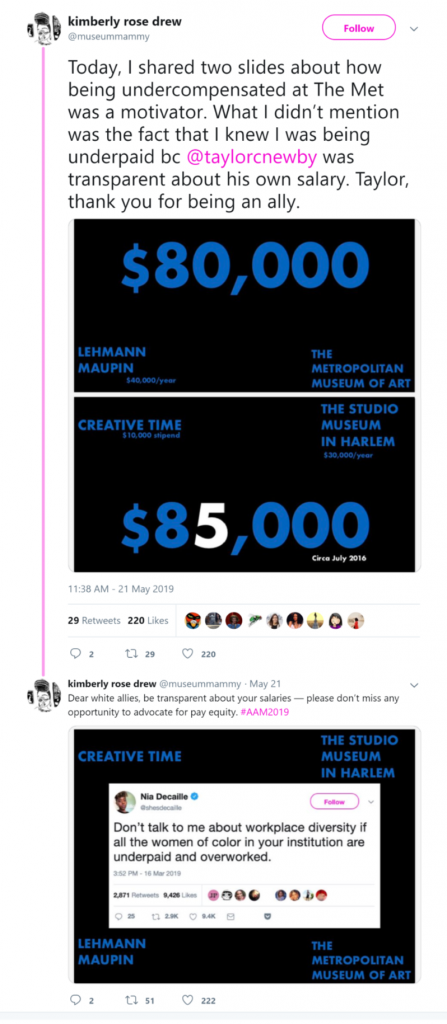Talking the Talk: Next Steps for the Salary Spreadsheet
You may have seen the Arts + All Museums Salary Transparency spreadsheet: a Google sheet of (at the time of this posting) nearly 2000 museum salaries from around the world. The nature of the data for each submission varies, but most entries include the name or type of museum, individual’s role and department, location, starting and ending salary, benefits, and required degree. Some individuals have also provided their gender and race. The bulk of the submissions come from museum professionals working in the United States, but the sheet also includes entries from countries such as Brazil, France, New Zealand, and the United Kingdom.

Michelle Millar Fisher, an assistant curator in the European decorative arts and design department of the Philadelphia Museum of Art, and colleagues created the spreadsheet to encourage transparency across the field after being inspired by Kimberly Rose Drew’s story of how she learned she had been undercompensated for her work at The Met. They may have also been inspired by a similar spreadsheet created weeks earlier by Alison Green of Ask A Manager for the same purpose: to “take the mystery out of salaries.”
At this point, the spreadsheet has grown 1800% since its first day and the story has been picked up by news sites such as Artnews, Artnet, Business Insider, Nonprofit Quarterly, and others. Fisher expressed her hope to Artnews that the spreadsheet “… encourages a conversation between coworkers… If you don’t do it, everything stays the same. Sometimes it takes just one tiny action. Solidarity is the only way to effect great change.”
Where do we go from here? What can you do?
- If you haven’t yet, look over the spreadsheet. It’s grown from a 100-entry sheet of mainly curatorial submissions to a nearly 2,000-entry behemoth of positions in administration, collections, digital, education, operations, security, visitor services, and other departments. If you’re interested in downloading a copy of the data, you may be able to obtain one by emailing the contact provided on the front page of the sheet.
- Submit your own entry. The spreadsheet has been locked to preserve its data, but you can (and should!) add your information through this Google form. While it has grown impressively, we’re still nowhere near a full picture of the field.
- Be open with your colleagues. Workplace etiquette has long dictated to keep mum about one’s salary, but silence perpetuates the status quo. Transparency about salaries and benefits exposes both institution-based and field-wide inequities.
- Speak up. In a NY Times article about the Ask A Manager spreadsheet, Liz Dolan of the podcast “Safe for Work” and formerly of the marketing teams for Nike and the Oprah Winfrey Network suggests “[asking] for regular raises, noting that the earnings compounded over time [are] considerable.” She also notes, “Sometimes you have to be first and that is the scary part… It’s important to build that confidence.” Whether you are applying for or already in a museum job, use the data from this spreadsheet and other resources such as annual wage surveys to bolster your ask for pay you deserve. (You can find additional pay-related resources under Tab 3: Other Resources on the spreadsheet.)
- Team up. Asking for change can be intimidating. Lean on and lend your support to colleagues if you or they decide to speak up.
- Share up. Transparency is important; action on the the information provided is doubly so. Share the spreadsheet and other salary data with the people with pockets (or paying power): museum leadership, board members, HR, you name it. They need to understand that this is an issue to be taken seriously, and – hopefully – with our voices combined, we may move the needle.